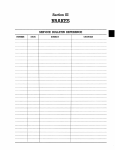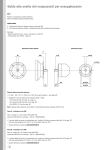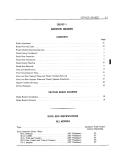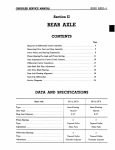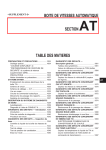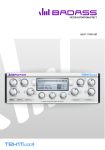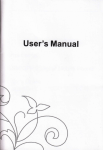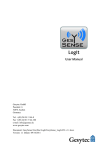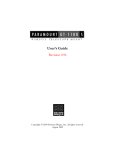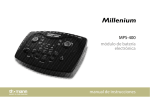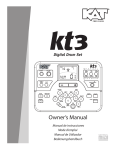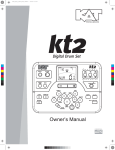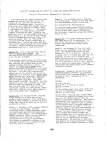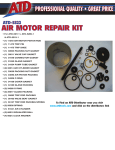Download BRAKES - jholst.net
Transcript
CHRYSLER SERVICE MANUAL BRAKES—17 REAR AXLE There is no basic design change in the rear axle and sure grip differential except the larger diameter pinion shaft is now used on all models for 1959. The Service Procedures will remain the same on the Rear Axle and Sure Grip Differential as specified in the 1958 Chrysler and Imperial Service Manual, D16350. Section III BRAKES DATA AND SPECIFICATIONS MODELS MC-1 TYPE DRUM DIAMETER MC-2, MC-3, MY-1 Total Contact (Floating Shoe) Hydraulic ... , 11 in. LINING Type Attachment Width Thickness 12 in. Moulded Asbestos Cyclebond 2Y2 in. l %i in- BRAKE SHOE RETURN SPRING TENSION USING FISH SCALE HOOKED AT TOE OF SHOE 35 to 45 lbs. required to break contact between shoe and push rod BRAKE PEDAL FREE PLAY % in. to J^ in. (in models with Power Brakes) WHEEL CYLINDER BORE Front—Upper and Lower Rear 1% in. 1K m - MASTER CYLINDER BORE V/% in. PISTON CLEARANCE .003 in. to .0065 in. HAND BRAKE MODELS MC-1, MC-2, MC-3, MY-1 TYPE Internal Expanding LOCATION Propeller Shaft at Rear of Transmission DRUM DIAMETER. LINING TYPE Length Width Thickness Clearance 7 inch , Moulded and Compressed Asbestos 13.06 inch 2 in. % m.015 in. to .020 in. 18—BRAKES CHRYSLER SERVICE MANUAL TOTAL CONTACT SERVICE BRAKES (Figs. 19 and 20) Servicing procedures outlined in the 1958 Chrysler and Imperial Service Manual, D-16350, will apply to the 1959 models with the exception of the removal and installation of the new brake shoe retainer. All brake shoes have a coil spring type guide. The guide retainer pin extends through the dust shield, the web of the shoe, a flat washer, the coil spring and the cupped retainer. Removal — While holding retainer pin in dust shield, push retainer toward brake shoe, turning the retainer to unlock it from the pin. Remove retainer, spring and washer from pin. Remove retainer pin from dust shield. Installation — Insert retainer pin through the dust shield and brake shoe. Install washer, spring and retainer on retainer pin. While holding retainer pin in dust shield, push retainer toward brake shoe, turning the retainer to lock it on the pin. MASTER CYLINDER The master cylinder used with power brakes has an adjustable pushrod. A new master cylinder assembly is used on Chrysler Models without power brakes. The new master cylinder has a non-adjustable push rod-and-piston stop which is permanently attached to the piston. The boot retainer is also a part of the assembly. The assembly is attached to the mounting face of the master cylinder body with two UPPER CYLINDER ADJUSTING C A M .- SHOE AND UNING DUST SHIELD-v. — SHOE RETAINER SHOE RETURN SPRING : SUPPORT-^ SHOE RETURN SPRING -ADJUSTING CAM SHOE RETAINE CONNECTING TUBE LOWfi? CYLINDER Fig. 19 —Total Contact Brake Assembly (Front) CYLINDER ASSEMBLY SHOE RE' SPRINGS ADJUSTING CAMS DUST SHIELD SHOE RETAINERS SUPPORT ANCHORS SHOE AND ^**z~~LINING Fig. 20 — Total Contact Brake Assembly (Rear) CHRYSLER SERVICE MANUAL screws. No attempt should be made to disassemble this push rod and piston. The combined action of the piston return spring and the pressure in the master cylinder is sufficient to hold the brake pedal in the "off" position, without a pedal return spring and pedal stop. The brake pedal should never be pulled back beyond the limit controlled by the piston stop. A minimum pull of 50 pounds could pull the piston off the push rod. PISTON TYPE POWER BRAKE UNIT The 1959 Chrysler and Imperial Models will have both the "Bellows Type" Power Brake as well as the "Piston, Type." The servicing procedure for the "Bellows Type" is the same as that in the 1958 Chrysler and Imperial Service Manual. The servicing procedure for the "Piston Type" is outlined below: The piston type power brake is an oval-shaped air-vacuum unit (Fig. 21) mounted on the engine side of the dash panel and is connected mechanically to the brake pedal linkage through the power unit push rod. A yoke at the end of the piston rod is in contact with the power lever pin of the reactionary linkage. The valve operating rod is located at the center of piston rod and is always in contact with a ramp at the upper end of the valve trigger arm of pedal linkage. A control valve operating rod (Fig. 21) moves within the piston rod to actuate the vacuum valve and poppet. The mechanical contact between the power unit BRAKES—19 and the brake linkage exists only when the power unit is assisting in a brake application. In the event there is a loss of engine vacuum, the brake pedal is free to function independent of the power unit to apply the brakes in the conventional manner. PEDAL LINKAGE ADJUSTMENTS (ON CAR) It should seldom be necessary to adjust the brake pedal trigger arm. Adjustment, however, may be necessary, occasionally, to eliminate the following conditions: If the pedal pressure releases slowly, adjust by rotating the adjustment screw in a counter-clockwise direction. A time delay (noted during a fast brake application), can usually be corrected by making a clockwise adjustment on the adjusting screw. Should the pedal vibrate (booster chatter), turn the adjusting screw in a counter-clockwise direction. NOTE: Rotation of adjustment screw should be limited to plus or minus 90 degrees about original setting. ASSEMBLY OF PEDAL LINKAGE IN PEDAL BRACKET CAUTION Use extreme care during assembly or handling of the linkage as the power brake pedal trigger arm is easily damaged. After reinstalling the brake pedal linkage in the pedal bracket, a wooden wedge should be placed between the power brake lever and the forward edge of the triangular hole in the pedal bracket (if power VACUUM VACUUM HOSE VACUUM CHAMBER VACUUM TUBE / VALVE PASSAGE / RETURN SPRING GASKET SPRING SEAL VALVE ROD RETURN SPRING AIR CLEANER ATMOSPHERIC VACUUM VALVE OPERATING £ CHAMBER ROD DIRECTION VALVE ATMOSPHERIC VALVE (PORT OPEN) (PORT CLOSED) Fig. 21 — P o w e r Brake Unit (Sectional View) 57x176 CHRYSLER SERVICE MANUAL 20—BRAKES ARBOR (TOOL) f-< ^ GAUGE BLOCK (TOOL) 57x17 Fig. 22 - Power Brake Unit (Exploded View) unit has been removed). This will prevent the trigger arm from extending beyond the extremities of the bracket. LUBRICATION Except for an occasional few drops of SAE 10W Engine Oil on the power brake lever pin bushings, the brake pedal linkage requires no further lubrication. The power unit will require no lubrication under normal usage. PEDAL FREE PLAY ADJUSTMENT After the master cylinder, booster, and pedal linkage are completely installed (and wooden wedge removed), a free play adjustment check should be made at no vacuum as follows: NOTE: Removing vacuum hose and pressing the brake pedal several times will aid in obtaining the no vacuum condition. Insert the blade of a screw driver between the rubber collar of the power brake trigger pivot and the rear side of elongated hole in the power brake lever, forcing them apart. NOTE: If the brake pedal and the power brake lever are not wedged apart, a false free play setting (which includes booster valve travel) will be measured at the pad end of the pedal. Check free play with linkage in this position by pushing lightly at the pad end of the brake pedal. Pedal free play travel should be between 1/32 and Vs inch. If pedal free play movement does not come within the required limits, adjustment is made by lengthening or shortening the push rod as required. ALTERNATE METHOD OF MEASURING PEDAL FREE PLAY Remove master cylinder push rod end pin. Using light finger pressure, move push rod forward until contact is made with the master cylinder piston. Attempt to insert the push rod pin through the power lever and push rod end hole. If the push rod must be pulled back to allow passage of the push rod end pin, free play is present. If the push rod must be pushed further into the master cylinder to allow passage of push rod end pin, no free play is present and an adjustment must be made at the push rod. POWER BRAKE a. Removal (Fig. 22) Place a wood wedge between power brake lever and CHRYSLER SERVICE MANUAL BRAKES—21 forward edge of triangular hole in pedal bracket, to prevent trigger arm from extending beyond extremities of bracket. NOTE: If pedal linkage is allowed to extend through hole in dash panel the trigger arm may be damaged. Disconnect vacuum hose at power unit. Remove attaching bolts at dash panel and carefully remove power unit assembly. END PLATE SPRING RETAINER PLATE POPPET DIAPHRAGM APPLYING DIAPHRAGM VALVE ROD APPLYING PIN TUBE AND PLATE ASSEMBLY VALVE ROD SEAL SPRING RETAINER WASHER NOTE: Use care to prevent loss of the pedal linkage cross pin. PISTON SPRING b. Disassembly Scribe across flange of cylinder and end plate as a guide to correct assembly (Fig. 23). ROD END SCREW (4) VACUUM HOSE VALVE ROD 57x201 Fig. 24 — Disassembly of Tube and Plate Assembly NOTE: Do not clamp yoke in vise during any operation. Install a new vacuum cylinder gasket and connect vacuum hose. Align vacuum cylinder and end plate scribe marks and assembly. Remove the cylinder shell and gasket, disconnecting the vacuum hose from the air cleaner cover. c. Installation Position the power brake unit on dash panel of car so that its axis inclines down toward front of car. (Fig. 28) CAUTION The vacuum tube must be in the lowest quadrant (Fig. 4 ) . Make certain the bead at outer diameter of diaphragm is in the annular groove of the tube and plate assembly. Install valve rod poppet and applying diaphragm. NOTE: Before installing the vacuum cylinder, make the following test. Depress the valve rod and at the same time, try to blow through the vacuum hose. Failure to blow through the hose indicates the poppet assembly is properly seated. VACUUM CYLINDER AIR CLEANER COVER NUT (4) END PLATE MATING MARKS AIR CLEANER HAIR NOTE: As yoke passes through dash panel, be sure that it engages pedal linkage correctly by sliding over nylon bushings on power brake lever cross pin. Install and connect master cylinder. Replace four hex nuts and lockwashers, tighten nuts securely, and release pedal. Install vacuum hose and hose clips, operate engine and check pedal free play. Refer adjustment on "pedal free play." d. Lubrication The power unit will require no lubrication under normal use. If the unit is disassembled for overhaul or repair, all oil seals and " 0 " rings must be suitably coated with silicone grease before assembly. RETAINING PINS STOP WASHER GASKET PISTON ROD BOLT AND LOCKWASHER (4) SCREWS (3) END PLATE 57 x 200 57x202 Fig. 23 — Removal of Air Cleaner and Vacuum Cylinder) Fig. 25 — Removal of Vacuum Piston, Spring and Piston Rod CHRYSLER SERVICE MANUAL 22—BRAKES PISTON LEATHER PACKING EXPANDER SPRING RETAINER PLATE COTTON WICK INSPECTION PORT SCREW GASKET PISTON ROD SEAL SCREW AND SEAL WASHER (4) MOUNTING RING SPRING PISTON PLATE EXPANDER SPRING SCREW (6) W GASKET END PLATE 57x203 Fig. 26 — Disassembly of Vacuum Piston 57x204 PEDAL LINKAGE Fig. 27 — Removal of Mounting Ring, Seal and Washer a. Removal from Pedal Bracket (Power Unit Installed) Remove pedal return spring, master cylinder push rod end pin and power brake pedal lever shaft. Rotate pedal linkage assembly counter-clockwise while withdrawing power lever cross pin from booster unit yoke. Scribe across the tube plate and piston plate to insure correct assembly. Remove the vacuum rod applying pin, and tube and plate assembly (Fig. 24). Remove the retainer plate, spring and valve as an assembly. Remove the nylon button and the valve rod seal. Remove the valve rod snap ring and remove the washer and spring. Remove the valve rod from the piston rod end. PEDAL TRIGGER ARM Remove the piston rod retaining pins from the piston and separate the piston and piston rod. Remove the piston rod and rubber stop washer (Fig. 25). Refer to Figure 26 and disassemble the piston. Separate the mounting ring from the end plate (Fig. 27). Remove the retaining spring, seal retainer, piston seal and rubber gasket. Remove the inspection port screw from the mounting ring. b. Cleaning and Inspection Clean all rubber parts in alcohol. Thoroughly wash all metal parts. If inspection reveals nicks or scratches on the piston rod, valve seat at end of valve rod, POWER BRAKE CYLINDER ASSEMBLY POWER LEVER PIN RETURN SPRING \ •——YOKE POWER LEVER PEDAL MOUNTING BRACKET TRIGGER *~^" PIVOT BOLT MASTER CYLINDER ASSEMBLY W PUSH ROD END PIN FRONT OF DASH PANEL ! ^. MASTER CYLINDER PUSH ROD Fig. 28 — Power Brake Unit Installed : TRIGGER ADJUSTING SCREW BRAKE PEDAL SHAFT ACCESSORY BELT DRIVES—23 CHRYSLER SERVICE MANUAL or valve seat at center of piston plate, replace parts. Replace an excessively worn leather packing or piston rod leather seal. c. Assembly Be sure all metal parts are clean and thoroughly dry. Refer to Figure 26 and assemble piston plate as follows: With ribbed portion up, position the leather packing and piston plate. Install the wick, expander spring and wick retainer plate. NOTE: Dip the wick in vacuum cylinder oil prior to installation. Refer to Figure 27 and assemble the mounting ring and end plate as follows: Insert the end plate mounting plate screws in the end plate and install the rubber gasket. Apply silicone grease to outer face of gasket around center hole. Position the piston rod seal and retainer and retaining spring. Coat the bearing surface of mounting1 ring with silicone grease and install the mounting ring (ribbed portion up). Slide the piston rod stop washer on the piston rod. CAUTION Before inserting the piston rod through the leather seal, cover approximately 1*4 inches of the piston rod with scotch tape to prevent the sharp edges of the piston rod from damaging the seal. Insert the piston rod through the seal and position the piston spring on the end plate. Insert the piston rod into the piston and install the retaining pins (Fig. 25). Insert the valve rod in the piston and install the valve rod spring, washer and snap ring. Install the valve rod seal and valve rod nylon button. Position the retainer plate, spring, and poppet on the piston. Install the tube and plate assembly. NOTE: Pedal is slotted to provide clearance for removal of brake pedal assembly. d. Installation of Pedal Linkage in Pedal Bracket CAUTION Use extreme care during assembly or handling of the linkage, as the power brake pedal trigger arm is easily damaged. After reinstalling brake pedal linkage in pedal bracket, a wooden wedge should be placed between power brake lever and forward edge of triangular hole in pedal bracket (if power unit has been removed). This will prevent trigger arm from extending beyond extremities of bracket. SERVICE DIAGNOSIS PEDAL RELEASES SLOWLY AFTER APPLICATION OR BRAKE PEDAL VIBRATES (BOOSTER CHATTER) LACK OF POWER ASSISTANCE (WHEN COLD) NOTE: This condition only occurs when the car has Pedal trigger arm improperly adjusted. Rotate linkage adjusting screw in counter-clockwise direction. See paragraph "Adjustments." been setting for a long period of time ( storage ). Unit must be disassembled, cleaned of all old lubricants, seals and diaphragm must be softened with silicone grease before unit will function properly. DELAY IN APPLICATION (NOTED DURING FAST BRAKE APPLICATION) Pedal trigger arm improperly adjusted. Rotate the linkage adjusting screw in a clockwise direction. See paragraph ''Adjustments." LEAKS IN BOOSTER (Whistle when Brake is Applied) a. Air leaks in vacuum lines. b. Leaks in power cylinder. Recondition complete power cylinder assembly. Section IV ACCESSORY BELT DRIVES The satisfactory performance of the belt driven accessories depends on the maintenance of the proper belt tension. If the specified tensions are not main- tained, belt slippage may cause engine overheating, lack of power steering assist, loss in air conditioning capacity, air suspension height control failure, re-







